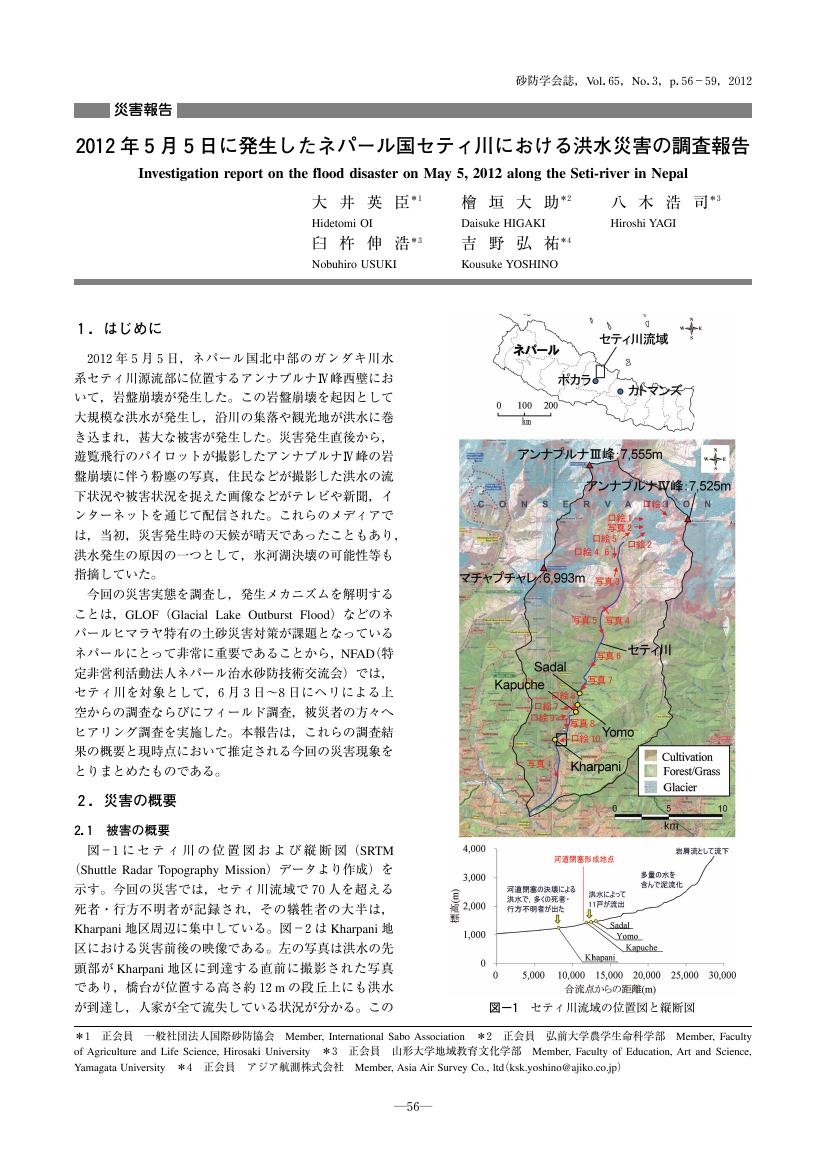1 0 0 0 OA 2012年5月5日に発生したネパール国セティ川における洪水災害の調査報告
- 著者
- 大井 英臣 檜垣 大助 八木 浩司 臼杵 伸浩 吉野 弘祐
- 出版者
- 公益社団法人 砂防学会
- 雑誌
- 砂防学会誌 (ISSN:02868385)
- 巻号頁・発行日
- vol.65, no.3, pp.56-59, 2012-09-15 (Released:2015-08-03)
- 参考文献数
- 1
- 被引用文献数
- 1
1 0 0 0 OA 津軽十二湖地すべり地における地学的・地生態学的な評価と観光客の動態とニーズ
- 著者
- 鄒 青穎 田口 一汰 佐藤 龍之世 石川 幸男 檜垣 大助 蔡 美芳 五十嵐 光 山邉 康晴
- 出版者
- 公益社団法人 日本地理学会
- 雑誌
- E-journal GEO (ISSN:18808107)
- 巻号頁・発行日
- vol.18, no.1, pp.142-156, 2023 (Released:2023-06-01)
- 参考文献数
- 31
- 被引用文献数
- 1
津軽十二湖地すべり地は,白神山地の最西部,青森県津軽国定公園にある約300年前の地震によってできた地すべりである.そこには,流れ山や舌状小尾根地形や巨礫や湖沼群など,十二湖を形成した地すべりの運動やその範囲を示す痕跡が各所に見られる.ここへの来訪者の多くは,推奨散策ルート沿いに1~4時間滞在し,池とブナ自然林の自然風景を鑑賞するために訪れている.来訪者は,地すべりに関連する池の成因や地形と植生との関係への興味が高いが,地学や地生態学的要素に関する情報は来訪者には伝わっていない.そうしたギャップを解消するため,十二湖の地形のできかたとその上に成り立った地すべり地形と植生の対応関係について調査を行い,それらへの理解が深まる散策ポイントを巡る散策マップを作成した.
1 0 0 0 OA 東北地方におけるスキー場開発の推移とその立地類型
- 著者
- 八木 浩司 高野 岳彦 中村 靖 村山 良之 檜垣 大助
- 出版者
- THE TOHOKU GEOGRAPHICAL ASSOCIATION
- 雑誌
- 東北地理 (ISSN:03872777)
- 巻号頁・発行日
- vol.43, no.3, pp.161-180, 1991-08-01 (Released:2010-04-30)
- 参考文献数
- 20
- 被引用文献数
- 3 2
東北地方のスキー場についてその開発過程を整理し, いくつかの視点から立地特性を検討して類型化を行い, スキー場の特徴の包括的な把握を試みた。東北地方における初期 (主に1950年代) のスキー場は温泉集落に付属するものが多数を占めたが, 1960年代には夏型観光地の田沢湖高原や磐梯山などにもスキー場が開かれた。また国体の開催を機にするもの、幹線交通路に接するもの, 都市近郊に開設されたものなど, 立地要因が多様化してきた。1974年以降はリフトの増設は低調になり, 温泉地スキー場の廃棄が目立った。1978年以後, スキー場開発は以前にないほど活発化かつ大規模化し, 人込み客数は急増した。これは, 高速交通体系の整備とレジャー時間の拡大に伴うものといえる。次にスキー場の類型把握のため, (1) 地形的条件, (2) 社会的条件, (3) 規模, (4) 開発経営主体の4点を整理検討した。はじめに, (1) によって以下の3つの自然立地的グループを設定した: i) 山麓型, ii) 山地中腹型, iii) 脊陵主稜型。次いでこれらと (2) を合わせて以下の7つの基本類型を設定した: i)…温泉地型, 集落近隣型, 都市近隣型, ii)…夏季観光地型, 交通依存型, iii)…景勝地亜高山型, 非景勝地脊梁型。これらと (3) (4) との対応から, 各類型の特徴を明確にした。
1 0 0 0 OA 北上山地中部の斜面物質移動期と斜面形成
- 著者
- 檜垣 大助
- 出版者
- 日本第四紀学会
- 雑誌
- 第四紀研究 (ISSN:04182642)
- 巻号頁・発行日
- vol.26, no.1, pp.27-45, 1987-05-31 (Released:2009-08-21)
- 参考文献数
- 57
- 被引用文献数
- 10 6
In this paper mass movement and slope formation in the central Kitakami Mountains are discussed with special reference to their periods. Many tephra layers of the late Quaternary found in the study area enable to study the periods of mass movement and slope formation tephrochronologically (Fig. 2).The slopes are classified as follows (Fig. 3). (1) gentle slopes on the summits, (2) piedmont gentle slopes, (3) fan-like gentle slopes, (4) smooth crest slopes, (5) upper head hollow slopes (continuing smoothly from the surrounding slopes), (6) lower head hollow slopes (smaller than (5), surrounded by clear breaks in slopes), (7) talus and alluvial cone, (8) other slopes. In the study area two periods of mass movement, chiefly by solifluction, are confirmed during the Last Glacial.The first period was in the early Last Glacial Stage, perhaps around 50, 000y.B.P., and the second was in the late Glacial Stage, between 30, 000 and 10, 000y.B.P..These periods of mass movement correspond to those of the involutions under periglacial climate in the Northern Kitakami Lowland area (Endo, 1977) (Fig. 7).In the study area not only were well-jointed bedrocks such as shale, slate, and schist susceptible to frost shatterin, bnt also fallen volcanic ash and soil produced from deep weathered bedrock were also susceptible to solifluction.Gentle slopes on the summits and smooth crest slopes have been formed by bedrock frost shattering and solifluction in these periods of mass movement by surface processes. Gentle piedmont slopes have been formed by solifluction. Upper head hollow slopes were developed as smoothly concave profiles by debris accumulation. Fan-like gentle slopes were developed chiefly by slope wash (partly by solifluction in the Last Glacial Stage) at the same time.Most of the piedmont gentle slopes and fan-like gentle slopes began to form in the early Last Glacial Stage or in the cold period before the Last Interglacial Stage, and the deposits of the late last Glacial Stage, which is generally recognized as the maximum period of the last Glacial Stage in Japan, are only 0.5-2.0m thick.During the warming period from the latest Pleistocene to Holocene, landslides have formed lower head hollow slopes and alluvial cones have been formed at the outlet of valleys with small river basins.
1 0 0 0 モレーンで堰き止められた氷河湖の形成機構と拡大機構に関する研究
近年の地球温暖化の影響であろうか、半世紀ほど前からヒマラヤ山脈の南北両斜面に発達する表面が岩屑に覆われた谷氷河消耗域の末端付近に、氷河湖が多数形成され始めた。ところが、同じ気候条件下にあり、同じような形態の谷氷河であっても、ある氷河には氷河湖が形成されているのに、他の氷河には氷河湖が形成されていない。何故ある氷河には氷河湖が形成され他の氷河には無いのであろうか?今回の研究によって、氷河内水系、岩屑に覆われた氷河の融解速度と氷河の上昇流速から計算される氷河表面の低下速度(氷厚の減少)を考慮した氷河湖形成モデルを導き出すことによって、この問題に対する回答を得ることができた。氷河湖が一旦形成されると、その拡大速度は非常に大きく、わずか30〜40年の間に、深さ100m、貯水量3000万〜8000万m^3もの巨大な湖に拡大成長する。何故これほどの高速で拡大するのであろう?氷河湖の拡大機構を以下のように説明出来ることが分かった。太陽放射で暖められた氷河湖表面の水が、日中卓越する谷風によって、湖に接する氷河末端部に形成されている氷崖へと吹送され、氷崖喫水線下部の氷体を効率よく融解する。そのため、下部を抉られた氷崖が湖へと崩れ落ちる(カービング)ことによって、湖は急速に上流側へと拡大する(氷河は逆に効率よく縮退する)。一方、湖底の氷は約2〜3℃の水温を持つ湖水で融解され、水深を増す。この両者によって湖は拡大している。湖の熱収支を計算すると、湖に崩れ落ち小氷山となって漂う氷の融解と湖底氷を融解させるに要する熱量は、アルベドの小さな湖表面が吸収した太陽放射エネルギーで主に賄われていることを確認した。研究成果の一部は3冊の英文報告書及び、3冊の邦文研究報告書として出版されている。
